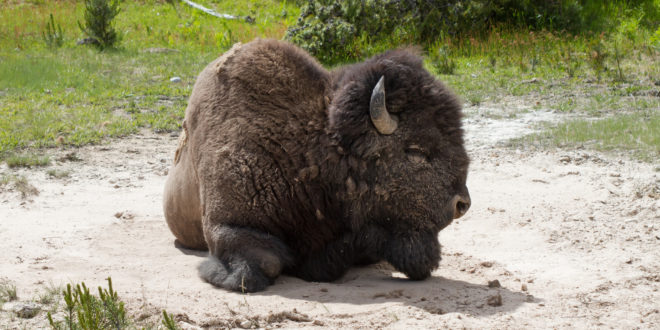Yellowstone National Park is closer to having a certified bison quarantine area in the existing Stephen Creek Bison Capture Facility.
The park announced in June its intention to establish a bison quarantine facility within park boundaries. After getting preliminary approval from the state in Montana in July, the park announced in August the quarantine area could be ready by the end of 2017.
According to the Bozeman Daily Chronicle, the park has completed some of the work outlined in their proposal—adding a second fence and upgrading the Stephens Creek water system—but has a long way to go still in getting certified:
“We’re not an official quarantine facility yet,” said Morgan Warthin, a park spokeswoman.
Officials from the Montana Department of Livestock and the U.S. Department of Agriculture’s Animal and Plant Health Inspection Service visited the trap last Thursday to inspect it. Marty Zaluski, Montana’s state veterinarian, said they should have a decision by the beginning of next week.
He said they still had concerns about spots where animals can get hurt and how snowmelt will drain, but added that those weren’t “make or break kind of deals.”
[Yellowstone bison biologist Rick] Wallen, with Yellowstone, said they’re also arguing over whether the bison that are being held there can be considered disease free.
Currently, there are 24 bison in Stephens Creek that were proposed for a bison quarantine facility at the Fort Peck Indian Reservation. The park originally kept 40 bison, which were later threatened with slaughter in order to clear space in Stephens Creek.
Montana Governor Steve Bullock interceded, placing a temporary ban on operations at Stephens Creek until the fate of those 40 bison were sorted out. As part of the deal that emerged, the 24 bison spared (all bulls) would need to go through quarantine and be cleared of brucellosis before they could be shipped to Fort Peck.
Although the bison were promised to Fort Peck, Montana state law prohibits the transit of animals infected with brucellosis, a disease prevalent in Yellowstone bison that causes cattle to abort and necessitates quarantining whole herds or even liquidating cattle.
This is the main reason for the Interagency Bison Management Plan, which started in 2000 and covers operations at Stephens Creek as well as annual bison hunts and slaughter programs.
Last winter, over 1,200 bison were killed, bringing the estimated population down to about 4,800 bison. There was also an appreciable drop in population among Yellowstone’s central bison herd, which surprised park biologists since it’s so far inside the park and (therefore) far from the scene of hunting and slaughter operations.
This winter, bison managers are looking to cull 600 to 900 bison.
Although bison are managed for their brucellosis transmission risk, there have been no documented cases of bison-to-cattle transmission. Indeed, recent research points to elk as posing a greater risk to cattle, which undercuts some of the rationale for bison management.
One example of this shift in understanding can be seen on the ground at Stephens Creek, according to the Chronicle:
The 24 that were caught in 2016 are in one corral. Another 28 caught in 2017 are in the other. All are male — meaning they’re an extremely low risk for spreading the disease — and all have repeatedly tested negative for brucellosis.
Because they haven’t been held in an official quarantine facility, they aren’t considered disease free by livestock officials. Among the upgrades key to this theory is the double fence — the idea is that an infected wild animal could have transmitted the disease to one of the captive bison when they were separated only by a single fence.
Wallen disagrees, and said that even if a bison had been infected it would have tested positive for the disease by now.
“They think there’s a certain risk,” Wallen said. “Our argument is that there’s very little risk.”
 Yellowstone Insider Your Complete Guide to America's First National Park
Yellowstone Insider Your Complete Guide to America's First National Park





